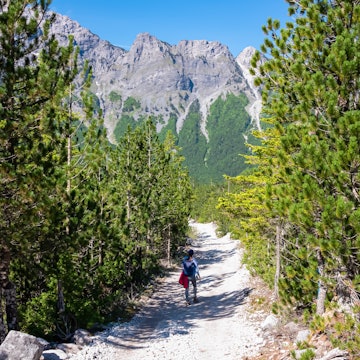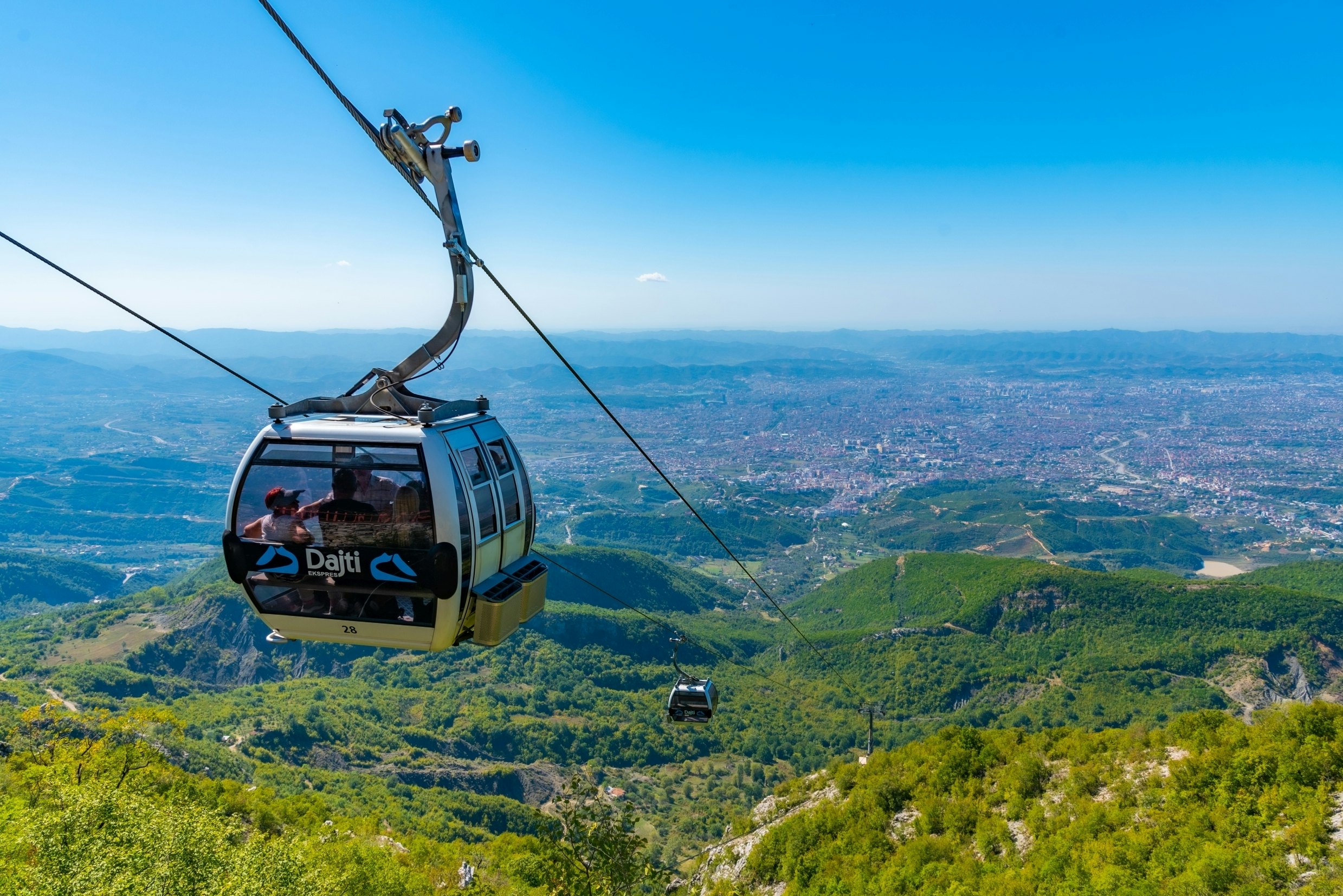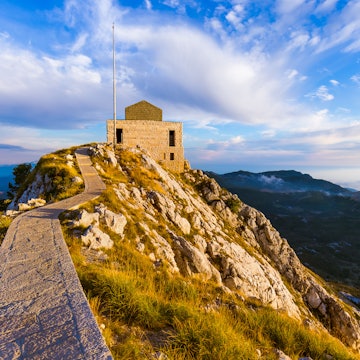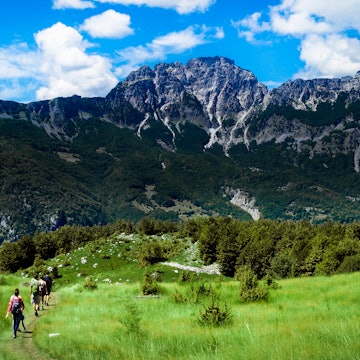

Namazgja Mosque. Kim Willems/Shutterstock
Albania’s capital, Tirana, was shut off from the world, like the rest of this Balkan country, for decades under communist rule. Tourism has only just begun evolving in the now increasingly cosmopolitan city over the past few decades, and as a result, first-time visitors are in for some fascinating cultural experiences.
Much of what you can see and do in Tirana revolves around its history, both ancient and recent, with some striking monuments and avant-garde art and architecture, much of it linked to Albania’s former leader Enver Hoxha.
It’s also easy to get out of the bustling center of the city, with expansive parks and rolling hills but a bus ride away. Here are 20 of the most interesting sights and experiences in and around Tirana.
1. Admire the Ottoman-style Namazgja Mosque
At an impressive 10,000 sq meters (110,000 sq ft), this mosque is the largest in the Balkans, standing proudly on Blvd Zhan d’Ark. It was inspired by classical Ottoman architecture and is reminiscent of Istanbul’s Blue Mosque. The four minarets reach up 50m (160ft), and the central dome rises to 30m (98ft). After the fall of communism, the mosque was deemed a necessary addition to the city, since there was no central mosque for Albanian Muslims. Construction finally started in 2015, and Namazgja opened in 2024; it can accommodate 10,000 worshipers.
Planning tip: Avoid major prayer hours, particularly on Fridays, and dress modestly; women should cover their heads, arms and legs, and men should wear long trousers.

2. Stroll around the main square
Sheshi Skënderbej (Skanderbeg Square), Tirana’s vast paved and polished main plaza, spreads over 3700 sq meters (40,000 sq ft). A popular gathering place for friends and families to meet, promenade and chat, it’s lined with several significant buildings, many dating from the communist era. It’s named after Albanian national hero Gjergj Kastrioti Skënderbeu, a 15th-century military commander who led a rebellion against the Ottoman Empire and became a symbol of resistance.
Planning tip: Come in the early evening, when residents amble through to the sounds of street musicians.
3. Marvel at the frescoes inside the Et’hem Bey Mosque
The frescoes that adorn this small, charming 18th-century mosque on Sheshi Skënderbej look almost as vibrant today as the day they were painted. Deep orange, verdant green, teal and periwinkle blue are used in the elaborate patterns that cover the walls and domed ceiling. There are captivating images of trees, waterfalls, bridges and various landscapes. One inscription reads: "The mosque has given eternal beauty to the city, as Hagia Sophia has given to Istanbul" – high praise indeed. While it was closed during Hoxha’s rule, it has returned to be a place of prayer for Tirana’s Muslim community.
Planning tip: The mosque is closed to visitors during prayer services. Arrive in the early morning or late afternoon, when the natural light shows off the frescoes at their best.
4. Step back in time at Tirana's castle
Known as the Fortress of Justinian, this Byzantine structure dates back to the 13th century. It used to be at the heart of the city and was solidly built with thick stone walls and watchtowers. Only a few of the original walls and foundations remain. Stores in the small bazaar inside sell handicrafts alongside a handful of traditional-style restaurants.
Planning tip: Bring comfortable shoes for navigating the cobblestones.

5. Explore Albania’s biggest museum
The first thing you’ll notice about the National History Museum is the striking mosaic above the entrance, the work of five local artists. The Albanians depicts figures throughout the country’s history, including soldiers fighting the Ottoman Empire, a communist worker and a representation of Mother Albania in national dress, all in social realist style. Artifacts date from Roman times, through the Middle Ages and Renaissance, to the modern era, with exhibits on independence, communism and national liberation.
Planning tip: Get there when it opens at 9am to avoid the crowds. As Albania’s biggest museum, it’s incredibly popular with locals and visitors alike.
6. Check the time at the Clock Tower
This city landmark was constructed between 1822 and 1830 by the poet Haxhi Et’hem Bey, after completing the mosque he built with his father, Molla Bey. At 35m (115ft) tall, it was the tallest structure in Tirana until the 1970s. You can climb up the 90 steps to the top for great views around Sheshi Skënderbej.
Planning tip: The spiral staircase is narrow and steep, so bring shoes with good grip.
7. Picnic in Tirana Lake Park
The lake that the park is named for is artificial, but that doesn’t detract from its appeal. Sitting on the edge of a huge green space in the southern part of the city, it’s the perfect place to spend a sunny day. Residents pass through doing morning runs, while on a break from the office or as a meeting spot in the evenings. It’s scattered with landmarks, including St Procopius Church and the Presidential Palace, as well as a swimming pool complex, zoo and botanical garden, home to over 120 species of plants, flowers and trees. An amphitheater hosts cultural events during the summer. Pack a picnic, find a shaded spot and settle in.
Planning tip: Avoid the heat of midday and come either in the late morning or early evening.

8. Enjoy the views from Mt Dajti National Park
Some 25km (15 miles) east of Tirana, this national park is a welcome break from the city. You can stay at ground level on one of the walking trails through the pine and beech forests, but for a real thrill, take the cable car to the top of Mt Dajti itself. The exhilarating 15-minute journey on the Dajti Express rewards you with unparalleled views down to Tirana and across the Adriatic Sea. At the top, there’s a small aerial adventure park and an 18-hole mini golf course. Stop in at the Ballkoni Dajti restaurant, which resembles a log cabin and serves traditional Albanian dishes and wine. If you’re feeling fit, you can walk back down.
Planning tip: The cable car stops running at 6pm, but go early in the morning, when the air is cooler and the lines haven’t gotten too long; tickets are available from 9am.
9. Snap a photo of the equestrian statue
This bronze statue of Albania’s national hero – atop a horse, with his sword drawn, leading his troops into battle against the Ottoman Empire – powerfully represents the country's pride, resilience and historical continuity. Three master sculptors collaborated on the monument in Sheshi Skënderbej, which was unveiled in 1968, three centuries after Skënderbeu’s death.
Planning tip: The statue is beautifully illuminated at night, making it the perfect time for a photo-op.
10. Gain an understanding of Albania’s recent past at Bunk’Art
Hoxha was obsessed with building bunkers – he was convinced that Albania would be invaded by enemies of communism during the Cold War. At his death in 1985, there were estimated to be over 750,000 bunkers. This one was built underground for the regime’s political elite in the 1970s and sprawls over 275 sq meters (3000 sq ft). It’s fascinating to explore these dank, dark tunnels, which combine an examination of Albania’s communist period, which began when Hoxha came to power in 1944, with contemporary art and installations. Look out for the vast Assembly Hall, where officials would gather, as well as the private living quarters; exhibitions display documents and photographs related to the period, plus a video of Hoxha’s state funeral.
Planning tip: Bunk’Art is located in the suburbs, close to the Dajti Express, so it’s worth including both sights in one day trip.

11. Examine Albania’s communist regime at Bunk’Art 2
In another former bunker a few minutes’ walk from Sheshi Skënderbej, Bunk’Art 2 has a somewhat eerie vibe. Along the mazelike concrete corridors and tunnels arranged over several floors underground are dozens of rooms displaying unsettling items, such as equipment used by the secret police (known as the Sigurimi) to spy on citizens, the apartment used by the minister of internal affairs and even a shower area for washing off radioactive materials in case of a nuclear attack.
Planning tip: If you’re traveling with children, be aware that some of the exhibits can be disturbing and are marked accordingly.
12. Attend a performance at the Palace of Culture
Tirana’s most important cultural hub: the low-slung white building houses the National History Museum, the National Gallery of Arts, the National Library of Albania and the National Theater of Opera and Ballet. The first stone was laid by former Soviet secretary Nikita Khrushchev in 1959.
Planning tip: Entry to the National Theater of Opera and Ballet isn’t permitted unless you have a ticket, but these are usually very cheap – from around 500 Albanian lek (US$6) – so it’s worth it just to have a look at the modernist interior.
13. See the Resurrection of Christ Orthodox Cathedral
A blend of Byzantine and modern architecture, this cathedral, opened in 2014, has some of the biggest contemporary Orthodox mosaics in the Balkans. Inside and out, it’s visually striking and guaranteed to be unlike most Orthodox churches you’ve ever seen.
Planning tip: Head here in the evening, when it’s atmospherically lit up.

14. Consider the quirky Pyramid of Tirana
Tirana’s distinctive Pyramid certainly stands out. Codesigned by Hoxha's daughter, Pranvera, an architect, it began life in 1988 as a museum dedicated to the former leader's legacy. Following communism’s collapse in 1991, it was used as a conference center, then as a NATO base in 1999 during the Kosovo War. It now operates as TUMO, a center for creative technologies, focusing on computer programming, robotics and start-ups. Staircases run up the sides, and glass panels flood the interior with light.
Planning tip: Climb the external steps or take the elevator to the viewing platform on the rooftop for fabulous panoramas of the city.
15. Walk by Hoxha's residence
Hoxha’s former home, Vila 31, is surprisingly modest. The three-story house in a district called Blloku (the Block) had luxurious touches, such as marble flooring and embellished hallways. Lush palm trees thrive in the manicured gardens. There was also a basement swimming pool and, of course, a hidden escape tunnel leading to an underground bunker. Today it functions as an arts space run by the Arts Explora foundation.
Planning tip: Vila 31 isn't permanently open to the public, so time your visit during an artists’ program.
16. Have a stylish night out in Blloku
Blloku was notoriously the district where communist bigwigs lived. But rather than being lavish and colorful, the area was gray and bleak – and a forbidden zone to citizens. Since the 1990s, this neighborhood has been utterly transformed into one of Tirana’s hippest, crammed with boutiques, bars, cafes and any number of fashionable restaurants. There’s plenty of foliage and street art crisscrossing the narrow streets, making it one of the most attractive parts of the city. Settle in for a sophisticated drink at a chic bar like Colonial, then head to a traditional restaurant such as Era for a taste of the local cuisine. Try a hearty dish such as tove kosi Elbasani (lamb cooked in yogurt) or fergese (cottage cheese with peppers and olive oil).
Planning tip: Have a sunset drink at the Sky Club bar in the Sky Hotel.
17. Make your own discoveries at the National Archaeological Museum
Treasures in this museum date to prehistoric times. Exhibits cover Illyrian tribes in the Bronze Age, classical antiquity, the Middle Ages and the modern era. More than 2000 objects found during archaeological research across the country are on display, from ancient jewelry to Roman statues, pottery, mosaics and coins.
Planning tip: Come earlier in the day when there’ll likely be fewer visitors and the natural light enhances the visibility of faded artifacts.

18. Shop for local delicacies at the New Bazaar (Pazari i Ri)
This bustling covered market is the place for souvenirs and fresh produce. Ringed by restaurants, the market holds dozens of stalls with local specialties, such as chestnut, pine or wildflower honey; jars of homemade ajvar (a roasted red pepper spread) and bottles of raki (Albania’s signature – and fiery – grape brandy). You’ll also find handicrafts such as woolen slippers, handwoven rugs, traditional hats, and carved woodenware. The atmosphere is animated, whether by day or night, as residents come to stock up on fruit and vegetables, as well as a good gossip.
Planning tip: Make sure to bring cash, as most stallholders don’t accept credit cards, and if you’re looking for the freshest produce, cheese or meat, get there in the morning.
19. Discover the secrets of surveillance at the House of Leaves
Despite its innocent-sounding name (courtesy of the ivy that used to cover the red brick facade), this unassuming building used to be the headquarters of Hoxha’s secret police. Now a museum where you can observe all the tricks of their trade, from bugs in broom handles to suitcases with hidden cameras, it may sound exciting but you can’t forget the truth: these officials made the lives of many innocent Albanians difficult, if not literally painful, through detention and torture.
Planning tip: Set aside an hour or two to fully absorb the exhibits and be prepared to confront somber topics such as political persecution, surveillance and authoritarian control.
20. Walk across the Tanners Bridge
Named for the leather workers who were based in the area and built this elegant stone footbridge in the 18th century, this structure connected the old road from the eastern highlands with the city market. It crosses the Lana River and was used by tanners and traders who brought livestock and goods across it to the bazaar. It’s one of the few surviving Ottoman-era structures in Tirana.
Planning tip: As the bridge is fairly small (and somewhat easy to miss), combine it with a visit to the New Bazaar. As you head from there along Rruga George W Bush, you'll pass remnants of old Ottoman neighborhoods and modern street art on the way to the bridge.














